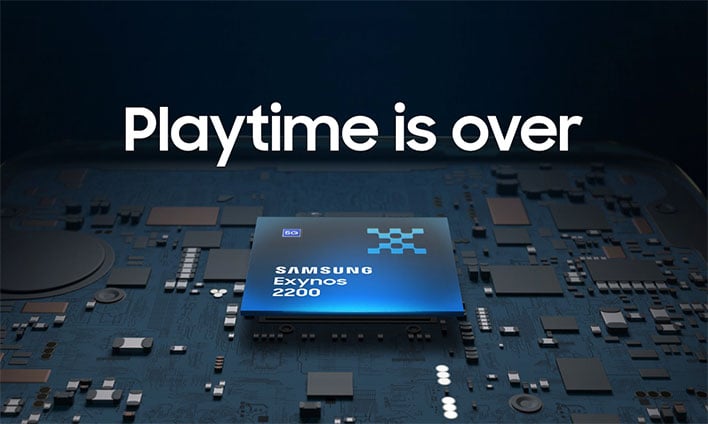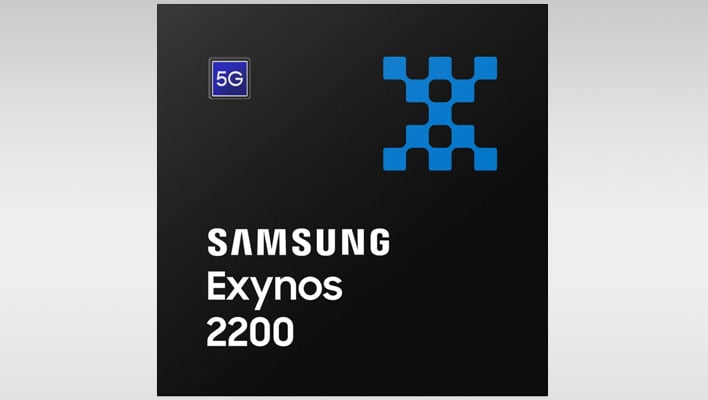Samsung Exynos 2200 With RDNA 2 Xclipse GPU Brings Ray Tracing Muscle To Premium Phones

So, how about all those Exynos 2200 rumors and reports? Turns out they were nonsense, at least the ones claiming it had been delayed indefinitely or even scrapped. There was indeed a bit of a wait for its arrival, but at long last, Samsung has officially lifted the curtain on its Exynos 2200 system-on-chip (SoC) infused with graphics based on AMD's RDNA 2 architecture.
"Playtime is over," Samsung's tagline reads, but really it's just beginning. Samsung calls the GPU "Xclipse 920" and it is the basis of the company's claim that the Exynos 2200 is a "game changing" chip for premium mobile smartphones.
"The Xclipse GPU is a one-of-a-kind hybrid graphic processor that is positioned between the console and the mobile graphic processor. Xclipse is the combination of ‘X’ that represents Exynos, and the word ‘eclipse’. Like an eclipse, the Xclipse GPU will bring an end to the old era of mobile gaming and mark the start of an exciting new chapter," Samsung says.
Samsung Exynos 2200 Is The First Mobile Chipset To Bring Hardware-Based Ray Tracing To Smartphones
This has been a long time coming, with Samsung and AMD partnering in 2019 for this very purpose. The Exynos 2200 with its Xclipse 920 GPU is the first real fruit of their joint efforts. Samsung isn't sharing a whole lot of specifics about the GPU just yet, and namely the clock speed, which has been the subject of various leaks and rumors. But in the meantime, what stands out is the introduction of hardware-based ray tracing for mobile phones.
Ray tracing is what could truly make the Exynos 2200 a game changing SoC, depending on how it performs in the real world. Same goes for variable rate shading, though the Exynos 2200 is the first to support VRS (so does the Snapdragon 888).
"AMD RDNA 2 graphics architecture extends power-efficient, advanced graphics solutions to PCs, laptops, consoles, automobiles and now to mobile phones. Samsung’s Xclipse GPU is the first result of multiple planned generations of AMD RDNA graphics in Exynos SoCs," said David Wang, Senior Vice President of Radeon Technologies Group at AMD. "We can’t wait for mobile phone customers to experience the great gaming experiences based on our technology collaboration."
Exynos 2200 Rocks A Tri-Core CPU Cluster Based On Armv9 Cores

The Exynos 2200 is built on a 4-nanometer extreme ultraviolet lithography process. On the CPU side, it sports a tri-cluster arrangement based on the new Armv9 CPU cores. These consist of a high-powered Cortex-X2 flagship core, three "balanced" Cortex-A710 cores for middling chores, and four power-efficient Cortex-A510 cores. There's also an AI engine baked in with a dual-core NPU and DSP.
There's also a redesigned ISP (image signal processor) that supports camera senors up to 200 megapixels, as well as 108MP at 30 frames per second in single-camera mode, and 64MP+32MP at 30 fps in dual-camera mode. And of course Samsung's latest chipset supports 5G technologies (sub-6GHz and mmWave).
We have not had a chance to test the Exynos 2200 yet, but benchmark leaks have it being competitive with Qualcomm's Snapdragon 8 Gen 1 in CPU performance, and trailing a bit on the GPU side. That could be due to lower-than-expected clocks, and if so, that could be rectified by the time the Exynos 2200 ships. We'll have to wait and see.
Regardless of how the benchmarks showdown shakes out, a competitive chipset with hardware-based ray tracing has the potential to be a big deal. Now the wait is on to see if the Exynos 2200 ends up in the Galaxy S22, which Samsung is likely to introduce at its Unpacked event next month. For now, Samsung says the Exynoss is currently in mass production.

